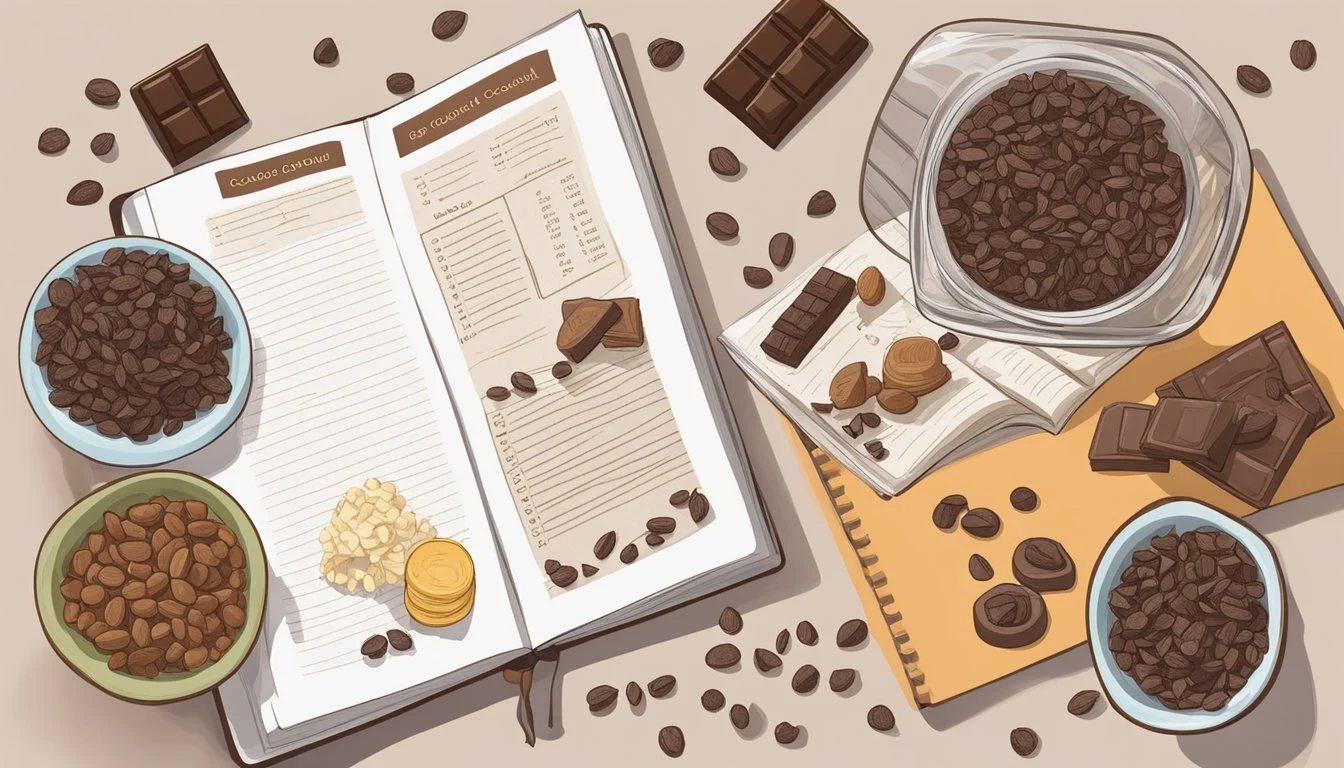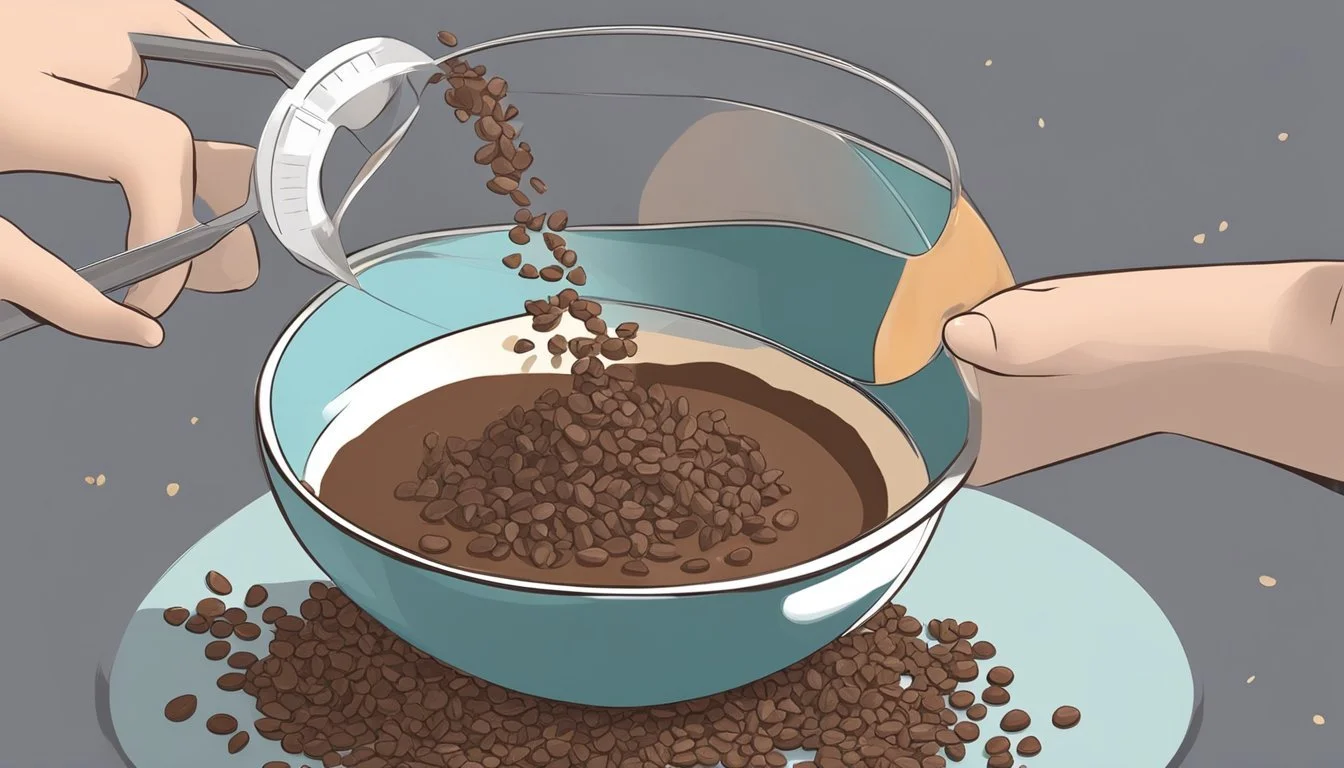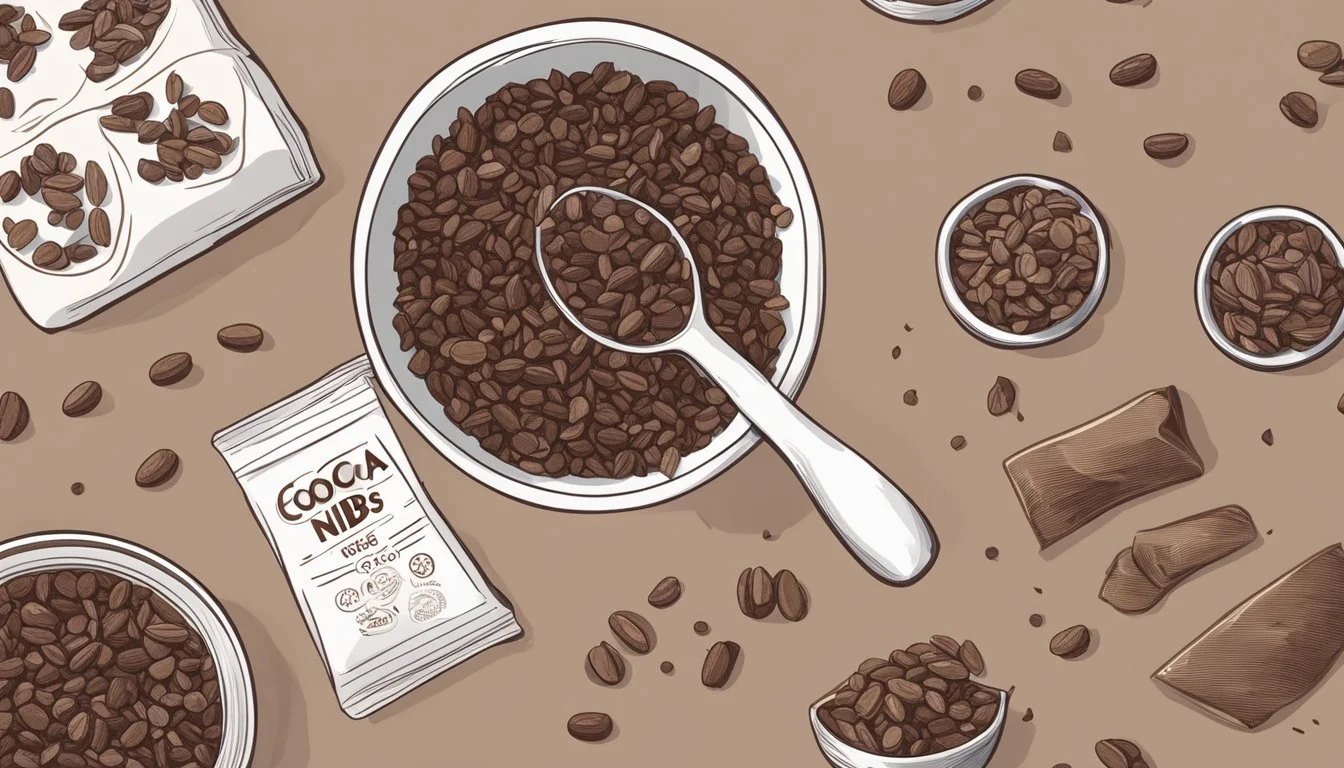How to Substitute Cocoa Nibs for Chocolate Chips
A Simple Baking Swap Guide
In the realm of baking and confectionery, the use of cocoa nibs as a substitute for chocolate (What wine goes well with chocolate?) chips is growing in popularity. Cocoa nibs, which are essentially crushed cacao beans, bring a depth of flavor and a distinct texture to various recipes. Unlike the creamy and sweet profile of traditional chocolate chips, cocoa nibs offer a more intense chocolate flavor with a slight bitterness. This characteristic is particularly favorable for those seeking to reduce sugar content while still indulging in a rich chocolate essence.
When substituting cocoa nibs for chocolate chips, it's essential to consider the differing taste profiles and textural elements. Cocoa nibs provide a crunchy and less sweet addition to baked goods, which can complement the overall flavor without overpowering it. They are versatile for incorporating into cookies, cakes, and even savory dishes where a hint of chocolate is desired. Despite their differences, cocoa nibs can be used in equal measure to chocolate chips in recipes, keeping in mind that the latter will melt and spread, while cocoa nibs will retain their shape and texture.
Understanding the properties of cocoa nibs enables bakers and chefs to make informed decisions when replacing chocolate chips in recipes. This substitute not only caters to varying dietary preferences but also opens the door to creative culinary exploration. It's an invitation to experience chocolate in one of its purest forms, enhancing recipes with an authentic cacao flavor that chocolate chips may not fully capture.
Understanding Cocoa Nibs and Chocolate Chips
In transitioning from cocoa nibs to chocolate chips or vice versa in recipes, it's important to understand their origins, taste profiles, and nutritional content to make effective substitutions.
Origin and Processing
Cocoa beans, or cacao beans, are derived from the Theobroma cacao tree. The process begins with roasted cacao beans which are cracked open to yield cacao nibs—these are the raw, pure essence of chocolate. In contrast, chocolate chips are made by adding sweeteners, such as sugar, and cocoa butter to processed cocoa solids, providing a sweeter and smoother flavor profile.
Flavor Profiles
Cacao nibs have a rich, complex, and noticeably bitter flavor due to the absence of added sugar and milk. Their texture is also crunchier. Chocolate chips, on the other hand, have a balanced sweetness and creaminess, allowing them to melt more uniformly, which is desirable in baking. The chocolate chips' flavor and texture will vary depending on the type and amount of sweeteners and additives used.
Nutritional Differences
When it comes to nutrition, cacao nibs are superior due to their minimally processed nature. They are high in fiber, antioxidants, and magnesium, contributing to their nutritional value. They also contain essential minerals, protein, and trace amounts of vitamin A and calcium. Chocolate chips typically have reduced nutritional benefits because of added sugars and lower cacao bean content. Consequently, cacao nibs are often a part of a healthier diet, while chocolate chips are considered a treat.
Substitution Basics
When substituting cocoa nibs for chocolate chips, it's essential to understand the balance between taste and texture to ensure your baked goods maintain their intended quality.
Ratio and Measurements
Cocoa nibs can typically replace chocolate chips at a 1:1 ratio by weight. This means if a recipe calls for one cup of chocolate chips, one can directly substitute with the same weight of cocoa nibs. It's crucial to use a kitchen scale for precision since cocoa nibs might be lighter in volume.
Chocolate Chips: 1 cup
Cocoa Nibs: Equal weight to chocolate chips
Texture Considerations
The texture of cocoa nibs is crunchier than that of melted chocolate chips, which are known for a chewier texture in baked goods. Cocoa nibs do not melt in the same way, providing a distinctly crunchy bite. For those who enjoy nuts like walnuts or almonds in their baking, cocoa nibs offer a similarly satisfying crunch. Their roasted flavor can also enhance the overall taste profile.
Chocolate Chips: Chewy and melty
Cocoa Nibs: Crunchy and roasted
Effect on Sweetness
Chocolate chips often contain sugar and can add a level of sweetness to a recipe. In contrast, cocoa nibs are typically less sweet as they are a more pure form of cacao. When substituting, one might consider balancing the reduction in sweetness by optionally adding a sweetener of choice.
Reduce sweetness: Use cocoa nibs as-is.
Maintain sweetness: Add a sweetener (e.g., sugar, honey) to taste.
Note: The presence of additional sugar or sweeteners in the recipe may need adjustment to prevent an overly sweet result.
Practical Substitution in Recipes
When substituting cocoa nibs for chocolate chips, bakers need to account for differences in texture and sweetness. Cocoa nibs impart a more intense chocolate flavor with a crunchier texture, while chocolate chips are sweeter and melt more uniformly.
Cookies and Brownies
In cookies and brownies, replacing chocolate chips with cocoa nibs can enhance the chocolatey taste without added sweetness. For each cup of chocolate chips, use three-quarters of a cup of cocoa nibs.
Textural Consideration: Cocoa nibs offer a crunch that can be a pleasant contrast in softer cookie doughs and fudgy brownies.
Flavor Adjustment: Since cocoa nibs are less sweet, bakers may want to adjust the sugar in the recipe accordingly.
Cakes and Pastries
For cakes and pastries, the substitution should be done with a bit more caution.
Cocoa Nibs to Chocolate Chips Ratio: Use about a half cup of cocoa nibs for every cup of chocolate chips to prevent overwhelming the baked goods with bitterness.
Melting Characteristics: Unlike chocolate chips, cocoa nibs don't melt the same way, providing a different texture to the final product.
Other Desserts and Treats
Cocoa nibs can be a versatile component in an array of desserts and treats including:
Ice Cream: A handful of nibs can be sprinkled on top or mixed into ice cream for an added crunch.
Candy: When making candy, substituting nibs for chips will result in a less sweet taste and a more pronounced chocolate flavor.
It's essential for the baker to remember that while cocoa nibs can directly replace chocolate chips in terms of volume or weight, the resulting flavor and texture will differ.
Adjusting Recipes for Cocoa Nibs
When substituting cocoa nibs for chocolate chips, a cook must consider their inherent bitterness and lower fat content. This often necessitates adapting the recipe with additional sweeteners or fats to achieve a balanced flavor and desired texture.
Additional Sweeteners or Fats
Cocoa nibs lack the added sugar that is present in chocolate chips. If a recipe calls for chocolate chips, which contain sugar, additional sweeteners may be required when using cocoa nibs. This could mean increasing the existing quantity of sugar in the recipe or adding a sweet component like honey or maple syrup. Cocoa nibs also contain less cocoa butter than chocolate chips, meaning additional fats such as butter, coconut oil, or shortening might be needed to retain moisture and richness.
Sugar Adjustment: Increase existing sugar by 10-25%, depending on desired sweetness.
Fat Compensation:
Butter: Add an extra 1 tablespoon per 1 ounce of cocoa nibs.
Coconut oil or shortening: Use in place of butter for dairy-free options.
Altering Baking Times and Temperatures
Cocoa nibs can affect the baking process due to their differing texture and fat content compared to chocolate chips. Bakers may need to modify baking times and temperatures to account for these differences. Recipes may require a slightly lower temperature or shorter baking time to prevent drying out or burning the nibs, which do not contain the higher fat content found in chocolate chips that helps to evenly distribute heat.
Baking Temperature: Reduce by 25°F if nibs are starting to burn.
Baking Time: Monitor closely and consider testing for doneness earlier than the recipe suggests.
Exploring Alternative Substitutes
When substituting cocoa nibs for chocolate chips in recipes, various alternatives can cater to different dietary needs and taste preferences, from healthier options to similar textures and diverse flavors.
Healthier Options
For those seeking a healthier alternative, carob chips stand out. They are naturally sweet and lower in fat than chocolate chips, making them a suitable option for a health-conscious diet. Similarly, yogurt chips provide a creamy texture and can serve as an alternative, though they are often higher in sugar. Nuts like toasted walnuts offer not only a healthful choice rich in Omega-3 fats but also contribute a satisfying crunch. Here's how some of these options compare:
Carob Chips: Lower fat, sweeter than cocoa.
Yogurt Chips: Creamy taste, higher in sugar, often non-vegan.
Toasted Walnuts: Rich in healthy fats, add crunchiness.
Similar Texture Additions
Those aiming to mimic the texture of chocolate chips may consider roasted cocoa beans, which provide a similar crunch. Nut butter chips, a blend of nuts and sweeteners, can also replicate the bite-sized morsels of chocolate chips while adding a distinct nutty flavor. For added texture in baked goods, consider these substitutes:
Roasted Cocoa Beans: Crunchy and mimic the texture of cocoa nibs.
Nut Butter Chips: Offer a similar size and bite to chocolate chips with a nutty flavor.
Flavor Variations
Exploring different flavors can lead to pleasant surprises in recipes. Vanilla can add a sweet and aromatic touch without the intensity of cocoa. Incorporating spices such as cinnamon can enhance the flavor profile while also providing a health boost. Similarly, adding caramel chips can create a rich, buttery flavor complexity to any dish. For those looking to replicate or complement the chocolatey aroma, here are some flavorful additions:
Vanilla: Adds a sweet, fragrant quality.
Caramel Chips: Contribute a rich, indulgent flavor.
Spices: Such as cinnamon, can introduce warmth and complexity.
Tips for Experimentation
When substituting cacao nibs for chocolate chips, it's important to consider flavor compatibility and dietary needs. Experimenting can lead to unique and satisfying results.
Introducing Variety
Substitutes for cacao nibs can include a range of options, each lending a distinct taste and texture. For added variety in recipes, consider the following alternatives:
Nuts: They provide a similar crunch and can add a new flavor dimension. Almonds, walnuts, or pecans are excellent choices.
Raisins: For a different kind of sweetness and texture, raisins are a good option, though they won't mimic the chocolate flavor.
Yogurt Chips: Offering a creamy texture, these can be melted and mixed into dough or batter.
Butterscotch Chips: They add a distinctive taste and creamy texture, suitable as a direct replacement for melted chocolate chips in recipes.
When one is experimenting, it's vital to start with smaller quantities and adjust according to taste and texture preferences.
Adjustment for Dietary Restrictions
For those with dietary restrictions or following a vegan diet, the substitutes for chocolate chips need careful consideration:
Vegan Options: Carob chips and certain dark chocolate chips can be excellent vegan-friendly alternatives, ensuring they contain no dairy.
Diet-Consistent Choices: For low-sugar diets, nuts and cacao nibs are better than sweetened chips. Check labels for added sugars or dairy if trying to keep recipes vegan or lower in carbohydrates.
It is advisable to always read ingredient labels to confirm that the substitutes align with one's dietary requirements.
Concluding Advice
In substituting cocoa nibs for chocolate chips, one should consider both the impact on the flavor profile and the nutritional content of the final dish.
Balancing Flavor and Nutrition
Cocoa nibs offer a uniquely bitter flavor and crunchy texture, characteristics that are less pronounced in chocolate chips. When seeking to replicate the deep chocolate essence of cocoa nibs, one might choose dark chocolate chips, which similarly contribute to the heart health benefits associated with high-flavanol cocoa. To ensure accurate flavor substitution, it is advisable to select chocolate chips with a high percentage of cacao.
Shifts in health benefits and nutritional impact are important considerations, as cocoa nibs generally contain fewer additives and sugars than chocolate chips, making them a more health-conscious option, particularly notable for their antioxidants. Those replacing cocoa nibs with chocolate chips should be mindful of the sugar content, as this can alter both the healthfulness and flavor intensity of the culinary creation. For the health-aware cook, seeking out chocolate chips with reduced sugar content or opting for cacao powder in a half-measurement for volume (as cocoa nibs have a stronger flavor) can help maintain nutritional balance.







